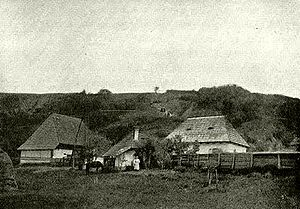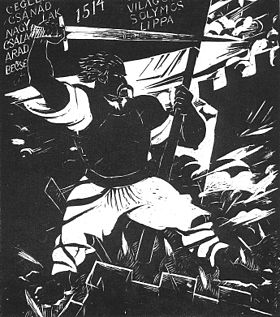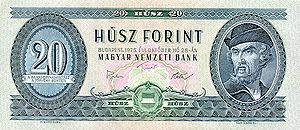- György Dózsa
-
 György Dózsa
György Dózsa
György Dózsa (or György Székely,[note 1] Romanian: Gheorghe Doja; 1470 - 20 July 1514) was a Székely Hungarian man-at-arms (and by some accounts, a nobleman) from Transylvania, Kingdom of Hungary who led a peasants' revolt against the kingdom's landed nobility. He was eventually caught, tortured, and executed along with his followers, and remembered as both a Christian martyr and a dangerous criminal. During the reign of king Vladislas II of Hungary (1490–1516), royal power declined in favour of the magnates, who used their power to curtail the peasants’ freedom.[1]
Contents
Outbreak of the rebellion
Born in Dálnok (today Dalnic), Dózsa was a soldier of fortune who won a reputation for valour in the wars against the Ottoman Empire. The Hungarian chancellor, Tamás Bakócz, on his return from the Holy See in 1514 (with a papal bull issued by Leo X authorising a crusade against the Ottomans[2]), appointed Dózsa to organize and direct the movement. Within a few weeks he had gathered an army of some 100,000 so-called kuruc, consisting for the most part of peasants, wandering students, friars, and parish priests - some of the lowest-ranking groups of medieval society. They assembled in their counties, and by the time Dózsa had provided them with some military training, they began to air the grievances of their status.
No measures had been taken to supply these voluntary crusaders with food or clothing; as harvest-time approached, the landlords commanded them to return to reap the fields, and, on their refusing to do so, proceeded to maltreat their wives and families and set their armed retainers upon the local peasantry. The rebellious, antilandlord sentiment of these “Crusaders” became apparent during their march across the Great Alföld, and Bakócz canceled the campaign.[3] Instantly, the movement was diverted from its original object, and the peasants and their leaders began a war of vengeance against the landlords.
Successes
By this time, Dózsa was losing control of the people under his command, who had fallen under the influence of the parson of Cegléd, Lőrinc Mészáros. The rebellion became more dangerous when the towns joined on the side of the peasants, and in Buda and other places the cavalry sent against the Kuruc were unhorsed as they passed through the gates. The rebellion spread quickly, principally in the central or purely Magyar provinces, where hundreds of manor houses and castles were burnt and thousands of the gentry killed by impalement, crucifixion, and other methods. Dózsa's camp at Cegléd was the centre of the jacquerie, as all raids in the surrounding area had it as their starting point.
In reaction, the papal bull was revoked, and King Vladislaus II issued a proclamation commanding the peasantry to return to their homes under pain of death. By this time the rising had attained the dimensions of a revolution; all the vassals of the kingdom were called out against it, and soldiers of fortune were hired in haste from the Republic of Venice, Bohemia and the Holy Roman Empire. Meanwhile, Dózsa had captured the city and fortress of Csanád (today's Cenad), and signaled his victory by impaling the bishop and the castellan.
Subsequently, at Arad, Lord Treasurer István Telegdy was seized and tortured to death. In general, however, the rebels only executed particularly vicious or greedy noblemen; those who freely submitted were released on parole. Dózsa not only never broke his given word, but frequently assisted the escape of fugitives. He was unable to consistently control his followers, however, and many of them hunted down rivals. At first, it also seemed as if the powers in the Kingdom were incapable of coping with him.
Downfall, execution
 Dózsa's execution (contemporary woodcut)
Dózsa's execution (contemporary woodcut)
In the course of the summer he took the fortresses of Arad, Lippa (today also called Lipova) and Világos (today also called Şiria), and provided himself with cannons and trained gunners; and one of his bands advanced to within 25 kilometers of the capital. But his ill-armed ploughmen were overmatched by the heavy cavalry of the nobles. Dózsa himself had apparently become demoralized by success: after Csanád, he issued proclamations which can be described as millenarian.[citation needed]
As his suppression had become a political necessity, he was routed at Temesvár (today Timişoara) by an army of 20,000[4] led by John Zápolya and István Báthory. He was captured after the battle, and condemned to sit on a heated smoldering iron throne with a heated iron crown on his head and a heated sceptre in his hand (mocking at his ambition to be king). While Dózsa was suffering, a procession of 9 fellow rebels, who had been starved beforehand, were led to such throne. In the lead was Dózsa's younger brother, Gergely, who was cut in three before Dózsa despite Dózsa asking for Gergely to be spared. Next, executioners removed hot pliers from fire and forced them into Dózsa's skin. After pulling flesh from him, the remaining rebels were ordered to bite where the hot iron had been inserted and to swallow the flesh. Those who refused, about 3 or 4, were simply cut up which prompted the remaining rebels to do as commanded. In the end, Dózsa died on the throne of iron from the damage that was inflicted while the rebels who obeyed were let go without further harm.[5]
The revolt was repressed but some 70,000 peasants were tortured.[6] György's execution, and the brutal suppression of the peasants, greatly aided the 1526 Turkish invasion as the Hungarians were no longer a politically united people. The Ottoman Turks were thus able to enter the country. Another consequence was the creation of new laws, an effort in the Hungarian Diet led by István Werbőczy. The resulting Tripartitum elaborated the Doctrine of the Holy Crown but also greatly enhanced the status of nobility, erecting an iron curtain between Hungarians until 1848 with the abolishment of serfdom.[7]
Legacy
Today, on the site of the martyrdom of the hot throne, there is the statue of The Virgin Mary, built by architect László Székely and sculptor György Kiss. According to the legend, during György Dózsa's torture, some monks saw in his ear the image of Mary. The first statue was raised in 1865, with the actual monument raised in 1906. A square, a busy six-lane avenue next to Hősök tere and a metro station in Budapest (Dózsa György út) bear his name, and it is one of the most popular street names in Hungarian villages (alongside Sándor Petőfi's and Lajos Kossuth's). Hungarian opera composer Ferenc Erkel wrote an opera about him (see Dózsa György).
A number of streets in several cities of Romania were named Gheorghe Doja, and his revolutionary image and Transylvanian background were drawn upon during the Communist regime of Gheorghe Gheorghiu-Dej. Also, a number of streets in serval cities of Serbia were named "Ulica Doža Đerđa". "The Hungarian national component of the movement led by him was de-emphasized, while its strong antifeudal character was highlighted.[8]
Sculptures
-
Nagylak, work by Lapis András
Notes
- ^ appears as "Georgius Zekel" in old texts
References
- ^ Britannica Dózsa Rebellion
- ^ Molnar p. 82
- ^ http://www.history.com/topics/hungary/page4
- ^ Molnar, p. 82
- ^ Barbasi p. 263-266
- ^ http://www.walkinhungary.com/history.html
- ^ Molnar p. 83
- ^ (Romanian) Emanuel Copilaş, "Confiscarea lui Dumnezeu şi mecanismul inevitabilităţii istorice", Sfera Politicii 139, September 2009
Sources
- Molnar, Miklos (2001). A Concise History of Hungary. Cambridge Concise Histories (Fifth printing 2008 ed.). Cambridge, United Kingdom: Cambridge University Press. ISBN 9780521667364.
 This article incorporates text from a publication now in the public domain: Chisholm, Hugh, ed (1911). Encyclopædia Britannica (11th ed.). Cambridge University Press.
This article incorporates text from a publication now in the public domain: Chisholm, Hugh, ed (1911). Encyclopædia Britannica (11th ed.). Cambridge University Press.- Barabási, Albert-László (2010). Bursts (First ed.). New York, United States: Penguin Group. ISBN 0525951601.
Categories:- 1470s births
- 1514 deaths
- People from Covasna County
- Executed revolutionaries
- History of Hungary
- History of Transylvania
- Mercenaries
- Peasant revolts
- Székely
- Executed Hungarian people
- 16th-century rebellions
Wikimedia Foundation. 2010.







